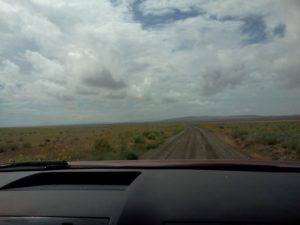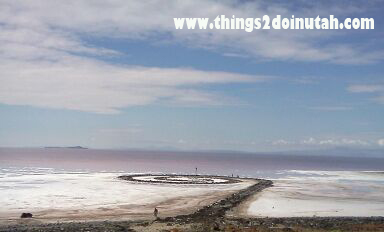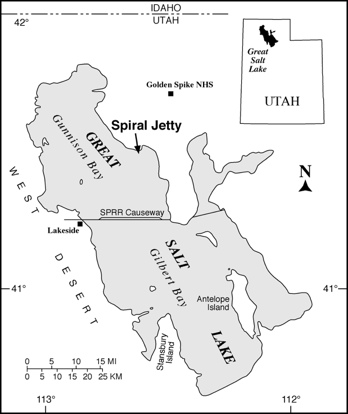The Spiral Jetty was created by Robert Smithson in 1970 and is located at Rozel Point peninsula on the northeastern shore of Great Salt Lake. Using over six thousand tons of black basalt rocks and earth from the site, Smithson formed a coil 1,500 feet long and 15 feet wide that winds counterclockwise off the shore into the water.
How was the Spiral Jetty Built?
With the assistance of a team operating dump trucks, a tractor, and a front loader, Robert Smithson created the Spiral Jetty sculpture in three weeks in April 1970. Over 6,000 tons of black basalt rocks and earth were formed into a coil jetting into the Great Salt Lake.
Immediately following its completion, Spiral Jetty was declared a momentous achievement in specialized art magazines, the press, as well as among Smithson’s peers, and it now continues to be recognized as an iconic artwork.
In 1999, Nancy Holt, Smithson’s widow, and the Estate of Robert Smithson, donated the Spiral Jetty to Dia Art Foundation.
Tips for visiting the Spiral Jetty:
1. Bring plenty of food and snacks, but please be sure to pick up after yourselves. Leave it better than you found it!
2. Bring water shoes if you have them. Bring a couple of towels too and a swimsuit if weather permits and you really want to get wet.
3. Bring band aids. The kids took their shoes off to walk in the water. The floor of the lake isn’t sand – it’s salt. Some of those salt areas are rock. Be prepared for a cut toe. 😉
4. Spiral Jetty is visible when water levels are below approximately 4,195 feet. To view water levels at the Great Salt Lake click here. We went when the water was at 4196 feet and had a great view with a lot to walk on!
5. It is gorgeous at sunrise and sunset. Check out those times here.
6. Have fun and take a lot of pictures!
How to Get to the Spiral Jetty:
1. From Salt Lake City take I-15 north approximately 65 miles to the Corinne exit (exit 365), just west of Brigham City, Utah. Exit and turn right onto Route 13 to Corinne. *LAST GAS STATION is in Corinne – MAKE SURE YOU HAVE PLENTY OF GAS.
2. Past Corinne, the road becomes Highway 83. Continue west for 17.7 miles. Follow signs to Golden Spike National Historic Site Visitor Center.
3. Turn left onto Golden Spike Road and continue 7.7 miles up the east side of Promontory Pass to Golden Spike National Historic Site Visitor Center. *LAST BATHROOMS are at the Visitor Center. *LAST CELL RECEPTION TOO.
4. From the Visitor Center, drive 5.6 miles west on the main gravel road to a fork in the road. Continue left, heading west. *There are small white signs directing you the entire way to Spiral Jetty.
5. Cross a cattle guard. Call this cattle guard #1. Including this one, you cross four cattle guards before you reach Rozel Point and Spiral Jetty.
6. Drive 1.3 miles south to a second fork in the road. Turn right onto the southwest fork, and proceed 1.7 miles to cattle guard #2.
7. Continue southeast 1.2 miles to cattle guard #3. YES YOU WILL THINK YOU ARE IN THE MIDDLE OF NOWHERE!

8. Continue straight 2.8 miles south-southwest to cattle guard #4 and an iron-pipe gate.
9. Drive south for another 2.7 miles around the east side of Rozel Point. You will see the north arm of Great Salt Lake and an old oil jetty (not Spiral Jetty) left by drilling explorations that ended in the 1980s.
10. The road curves turning north and ends at a cul-de-sac parking lot directly next to Spiral Jetty.
About the Artist:
Robert Smithson was born in Passaic, New Jersey, on January 2, 1938. In 1953, as a high-school student, he won a scholarship to the Art Students League of New York, where he studied in the evenings for the next two years, also taking classes at the Brooklyn Museum Art School in 1956. Smithson’s first solo exhibition was in 1959, at the Artists Gallery, New York. In 1964, he began to produce what he considered his first mature works of writing and sculpture. In 1973, Smithson died in a plane crash in Amarillo, Texas, while working on the earthwork Amarillo Ramp. Major retrospectives of his work have been organized by the Herbert F. Johnson Museum of Art, Cornell University, Ithaca, New York (1980); the National Museum of Contemporary Art, Oslo (1999); and the Museum of Contemporary Art, Los Angeles (2004). Recent solo exhibitions on his work include Robert Smithson in Texas at the Dallas Museum of Art (2013–14) and Robert Smithson: New Jersey Earthworks at the Montclair Art Museum, New Jersey (2014).


[…] 21. Drive out to the Spiral Jetty […]